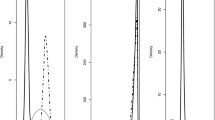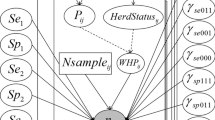Abstract
A common assumption made in studies involving two or more binary diagnostic tests in the absence of a gold standard is one of conditional independence among tests given disease status. Although reasonable in some cases, often this assumption is untenable or untested and may lead to biased results. We proposed a class of hierarchical models for the purpose of estimating the herd-level prevalence distribution and the accuracies of two tests in the absence of a gold standard when several exchangeable populations with differing disease prevalence are available for sampling, relaxing the assumption of conditional independence between tests. The models are used to estimate the prevalence of bovine brucellosis in Mexican cow herds and to estimate the error rates of two tests for the detection of swine pneumonia.
Similar content being viewed by others
References
Antoniak, C. E. (1974), “Mixtures of Dirichlet Processes with Applications to Bayesian Nonparametric Problems,” The Annals of Statistics, 2, 1152–1174.
Berry, D. A. and Christensen, R. (1979), “Empirical Bayes Estimation of a Bionomial Parameter via Mixtures of Dirichlet Processes,” The Annals of Statistics, 7, 558–568.
Dendukuri, N. and Joseph, L. (2001), “Bayesian Approaches to Modeling the Conditional Dependence Between Multiple Diagnostic Tests,” Biometrics, 57, 208–217.
Enøe, C., Georgiadis, M. P. and Johnson, W. O. (2000), “Estimation of Sensitivity and Specificity of Diagnostic Tests and Disease Prevalence When the True Disease State is Unknown,” Preventive Veterinary Medicine, 45, 61–81.
Escobar, M. D. (1994), “Estimating Normal Means with a Dirichlet Process Prior,” Journal of the American Statistical Association, 89, 268–277.
Escobar, M. D., and West, M. (1995), “Bayesian Density Estimation and Inference Using Mixtures,” Journal of the Amrican Statistical Association, 90, 577–588.
Feld, N. C., Qvist, P., Ahrens, P., Friis, N. F. and Meyling, A. (1992), “A Monoclonal Blocking ELISA Detecting Serum Antibodies to Mycoplasma hyopneumoniae,” Veterinary Microbiology, 30, 35–46.
Ferguson, T. S. (1973), “A Bayesian Analysis of Some Nonparametric Problems,” The Annals of Statistics, 1, 209–230.
Gardner, I. A., Stryhn, H., Lind, P., and Collin, M. T. (2000), “Conditional Dependence Between Tests Affects the Diagnosis and Surveillance of Animal Diseases,” Preventive Veterinary Medicine, 45, 107–122.
Gelfand, A. E., and Smith, A. F. M. (1990), “Sampling-Based Approaches to Calculating Marginal Densities,” Journal of the American Statistical Association, 85, 398–409.
Gelman, A., Carlin, J. B., Stern, H. S., and Rubin, D. B. (1995), Bayesian Data Analysis, London: Chapman and Hall.
George, E. I., Makov, U. E., and Smith, A. F. M. (1993), “Conjugate Likelihood Distributions,” Scandinavian Journal of Statististics, 20, 147–156.
Gilks, W. R., and Wild, P. (1992), “Adaptive Rejection Sampling for Gibbs Sampling,” Applied Statistics, 41, 337–348.
Hanson, T. E. (2000), “Applied Bayesian Semiparametric Methods with Special Application to the Accelerated Failure Time Model and to Hierarchical Models for Screening,” unpublished Ph.D. dissertation, Department of Statistics, University of California at Davis.
Hanson, T. E., Johnson, W. O., and Gardner, I. A. (2000), “Log-linear and Logistic Modeling of Dependence Among Diagnostic Tests,” Preventive Veterinary Medicine, 45, 123–137.
Huber, J. D., and Nicoletti, P. (1986), “Comparison of the Results of Card, Rivanol, Complement-Fixation, and Milk Ring Tests with the Isolation Rate of Brucella abortus from Cattle,” American Journal of Veterinary Research, 47, 1529–1531.
Hui, S. L., and Walter, S. D. (1980), “Estimating the Error Rates of Diagnostic Tests,” Biometrics, 36, 167–171.
Hui, S. L., and Zhou, X. H. (1998), “Evaluation of Diagnostic Tests Without Gold Standards,” Statistical Methods in Medical Research, 7, 354–370.
Johnson, W. O., Gastwirth, J. L. and Pearson, L. M. (2001), “Screening Without a ‘Gold Standard’: The Hui-Walter Paradigm Revisited,” American Journal of Epidemiology, 153, 921–924.
Joseph, L., Gyorkos, T., and Coupal, L. (1995), “Bayesian Estimation of Disease Prevalence and the Parameters of Diagnostic Tests in the Absence of a Gold Standard,” Amrican Journal of Epidemiology, 141, 263–272.
Qu, Y., Tan, M., and Kutner, M. H. (1996), “Random Effects Models in Latent Class Analysis for Evaluating Accuracy of Diagnostic Tests,” Biometrics, 52, 797–810.
Sinclair, M. D., and Gastwirth, J. L. (1996), “On Procedures for Evaluating the Effectiveness of Reinterview Survey Methods: Applications to Labor Force Data,” Journal of the American Statistical Association, 91, 961–969.
Sorensen, V., Barfod, K., and Feld, N. C. (1992), “Evaluation of a Monoclonal Blocking ELISA and IHA for Antibodies to Mycoplasma hyopneumoniae in SPF-pig Herds,” Veterinary Record, 130, 488–490.
Stemshorn, B. W., Forbes, L. B., Eaglesome, M. D., Nielsen, K. H., Robertson, F. J., and Samagh, B. S. (1985), “A Comparison of Standard Serologic Tests for the Diagnosis of Bovine Brucellosis in Canada,” Canadian Journal of Comparative Medicine, 49, 391–394.
Suess, E. A., Gardner, I. A., and Johnson, W. O. (2002), “Hierarchical Bayesian Model for Prevalence Inferences and Determination of a Country’s Status for an Animal Pathogen,” Preventive Veterinary Medicine, 55, 155–171.
Tierney, L. (1994), “Markov Chains for Exploring Posterior Distributions,” The Annals of Statistics, 22, 1701–1762.
Torrance-Rynard, V. L., and Walter, S. D. (1997), “Effects of Dependent Errorrs in the Assessment of Diagnostic Test Performance,” Statistics in Medicine, 16, 2157–2175.
Vacek, P. M. (1985), “The Effect of Conditional Dependence on the Evaluation of Diagnostic Tests,” Biometrics, 41, 959–968.
Walter, S. D., and Irwig, L. M. (1988), “Estimation of Error Rates, Disease Prevalence, and Relative Risk from Misclassified Data: A Review,” Journal of Clinical Epidemiology, 41, 923–937.
Yang, I., and Becker, M. P. (1997), “Latent Variable Modeling of Diagnostic Accuracy,” Biometrics, 53, 948–958.
Author information
Authors and Affiliations
Corresponding author
Rights and permissions
About this article
Cite this article
Hanson, T., Johnson, W.O. & Gardner, I.A. Hierarchical models for estimating herd prevalence and test accuracy in the absence of a gold standard. JABES 8, 223–239 (2003). https://doi.org/10.1198/1085711031526
Received:
Revised:
Issue Date:
DOI: https://doi.org/10.1198/1085711031526




